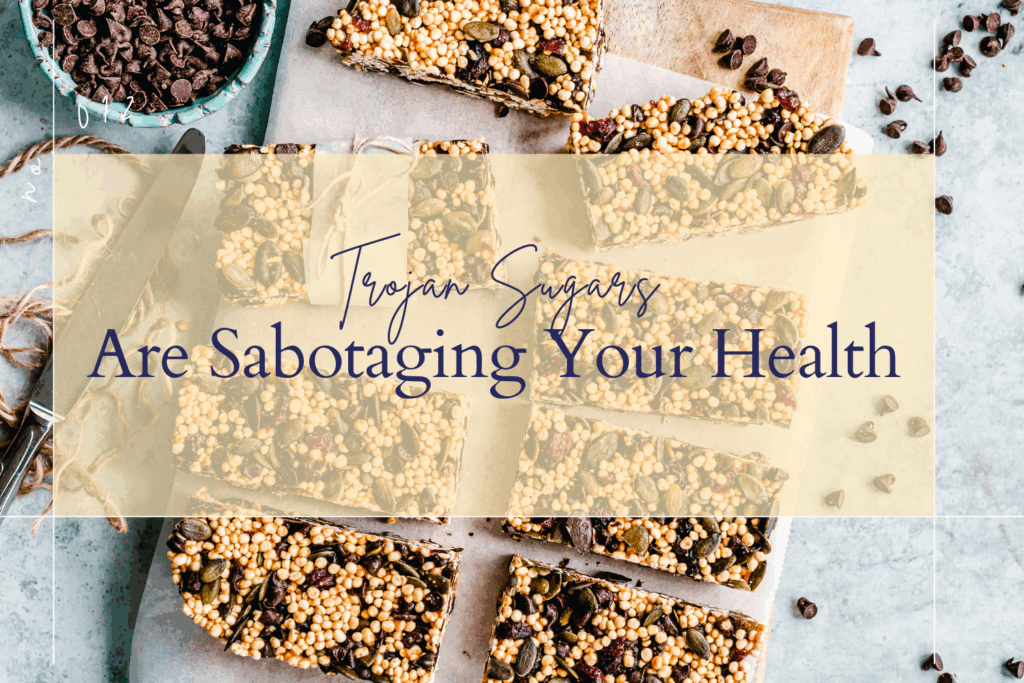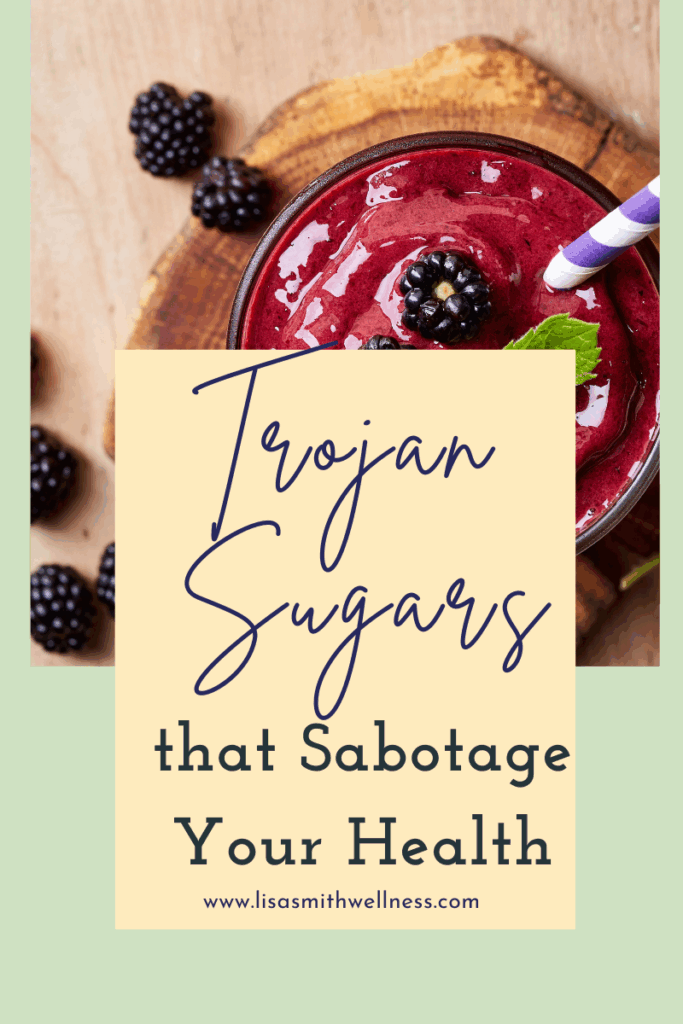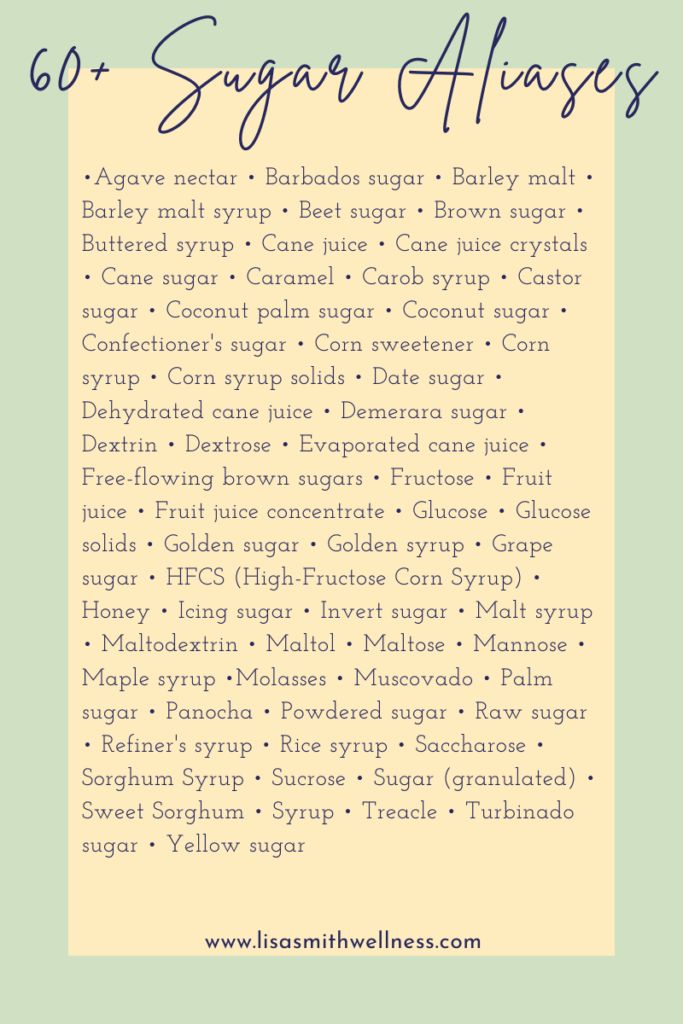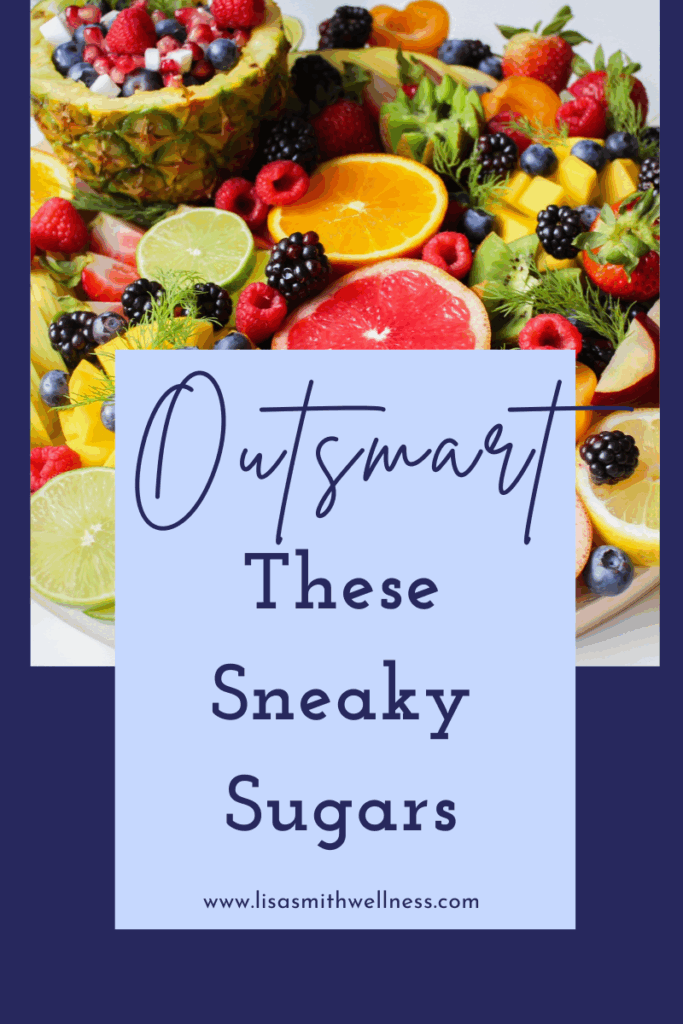Let’s set the scene: you want to avoid sugar so you’re making “better” food choices. You swap your soda for a green juice, your cookies for protein bars, your dessert for coconut milk yogurt with a dash of granola. You’re basically one turmeric shot away from sainthood.
And yet… your energy’s crashing by 3 p.m., your skin’s a mess, and your jeans are squeezing the life out of you.
Sound familiar? It’s not just bad luck or slow metabolism. In fact, it’s probably the Trojan sugars—those sneaky sweeteners hiding inside your so-called “healthy” foods.
If you’ve ever bought something that looked wholesome but left you bloated, jittery, or hangry, you’ve met them. Surprisingly, here’s the kicker: they’re doing way more damage than you think.
This post contains affiliate links meaning I make a small commission at no extra cost to you. Thank you for supporting the work of Lisa Smith Wellness and the Pretty Well Podcast!

What the Heck Is a “Trojan Sugar”?
Let’s go full Greek mythology for a second. Remember the giant wooden horse gifted to the Trojans that secretly housed an army? Yeah—some of your food is doing the same thing. Only instead of warriors, it’s carrying blood sugar spikes, hormone imbalances, inflammation, and your brain begging for a nap at 3 p.m.
It’s the granola bar labeled “natural” that has 18g of sugar. The “sugar-free” yogurt packed with artificial sweeteners that confuse your body and mess with your gut. That morning smoothie that sounds healthy but hits your bloodstream like a dessert disguised as breakfast.
The problem? Most of these “wellness” foods come dressed in health halos and marketing buzzwords. “Low-fat.” “Plant-based.” “Gluten-free.” “Low Sugar.” And tucked quietly beneath them? Hidden sugars or artificial sweeteners that do everything but support your health.
Why This Matters (More Than You Think)
You probably already know sugar isn’t great. But sneaky, rebranded sugar? That stuff is clever.
We’re talking about:
- Energy crashes
- Brain fog
- Inflammation
- Irritability
- Premature aging
- Gut dysbiosis
- Blood sugar chaos
- Hormonal havoc
- Skin issues (yes, it shows up on your face, too)
And if you’re dealing with acne, rosacea, resistant belly fat, or feeling like your mood swings need a referee… sugar might be calling the shots behind the scenes.

Meet the Hidden Sugar Mafia: 60+ Names and Counting
If only food labels said “Hey, this is going to jack up your blood sugar and make you hangry by 10:15 a.m.”, life would be simpler. But sugar rarely calls itself sugar. It uses aliases—more than 60 of them, in fact.
A few of its favorite disguises:
- Evaporated cane juice
- Brown rice syrup
- Agave nectar
- Maltodextrin
- Dextrose
- Fruit juice concentrate
- Barley malt
- Corn syrup solids
- Crystalline fructose
Even “organic cane sugar” is still… sugar.
And get this: over 70% of barcoded grocery items contain added sweeteners. That includes salad dressings, nut butters, yogurts, plant milks, and yes—those protein powders with the minimalist packaging and $60 price tag.
Pin this for Later

The “Healthy” Foods That Are Actually Sugar Bombs
Some of the biggest offenders in the sneaky sugar game are the ones you’d least expect. Here’s a hit list of health food fakes that might be playing you:
1. Yogurt
Most conventional yogurts (even the Greek kind) have 15–25 grams of sugar per serving. That’s basically a dessert with probiotics.
2. Protein Bars
You may as well have a candy bar in some cases. If sugar is one of the first three ingredients, put it down.
3. Smoothies
Fruit-on-fruit-on-fruit is basically a blood sugar rollercoaster. Especially when they sneak in juices, acai, sherbet, or “protein boosts” sweetened with syrupy powders.
4. Oat Milk & Plant-Based Milks
Check the label. Many are sweetened—sometimes heavily. Even “unsweetened” versions can be high in carbohydrates that spike blood sugar fast, depending on the type of milk.
5. Granola
A small bowl of granola can pack more sugar than a glazed donut. Don’t let the flax and chia seeds fool you—they’re just the garnish on a dessert in disguise. Look for lower-sugar options (Pro tip: anything labeled “Paleo” is usually a safer bet).
6. Dressings, Sauces, and Marinades
From ketchup to teriyaki to balsamic vinaigrettes—it’s sugar city. And nobody’s measuring two tablespoons.
Artificial Sweeteners: The Other Wolf in Wellness Clothing
Just because a label says “sugar-free” doesn’t mean it’s safe. In fact, the stuff they use to replace sugar might be worse.
Artificial sweeteners like:
- Aspartame
- Sucralose
- Saccharin
- Acesulfame K
These are hundreds of times sweeter than sugar, which sounds efficient until you realize they mess with your gut microbiome, spike insulin (yep, even without calories), and may contribute to headaches, mood issues, and long-term metabolic disruption.
One particularly wild story? A woman experiencing MS-like symptoms—numbness, tingling, fatigue—turned out to be reacting to her diet soda habit. She cut the artificial sweeteners… and the symptoms vanished. Not saying that’s everyone, but if that’s not a red flag, I don’t know what is.
What About the “Natural” Sugar Alternatives?
Now before we spiral into despair, let’s talk about some options.
Some natural alternatives that don’t send your blood sugar into orbit:
- Stevia
- Monk fruit
- Pure maple syrup (sparingly)
- Raw honey (sparingly)
- Dates (again—watch portions)
These have fewer metabolic drawbacks and don’t trigger the same insulin surge. But heads up: some are way sweeter than sugar, so go easy unless you want your taste buds recalibrated to “cotton candy.”
Also: your best “sweetener” might just be retraining your palate to not expect everything to taste like dessert. It only takes about 2 weeks to retrain your taste buds…and is more than worth the effort.
How to Outsmart Sneaky Sugars (Without Living in a Cave)
If this all feels overwhelming, take a breath. You don’t have to quit everything cold turkey and live on celery. Start small. Start smart.

1. Get Label-Literate
If you don’t recognize an ingredient, Google it. If you can’t pronounce it, you probably don’t need to eat it.
2. Stick to Whole Foods Most of the Time
The fewer barcodes in your cart, the better.
3. Pair Your Carbs Wisely
Protein, fat, and fiber help blunt the blood sugar response from carbs. Think: apple with almond butter > apple alone.
4. Don’t Fear All Fruit—But Respect It
Berries are your BFF. Bananas and grapes? May be too high glycemic when you’re trying to stabilize blood sugar.
5. Make Peace with Bitters
The more you reduce sugar, the more you start to like the taste of real food again. I promise.
TL;DR (Too Long, Didn’t Read)
- Sugar is sneaky.
- It’s hiding in “healthy” foods like yogurt, granola, smoothies, and sauces.
- It’s often disguised under names like maltodextrin, brown rice syrup, and fruit juice concentrate.
- Artificial sweeteners aren’t innocent either—they may cause gut issues, mood changes, and weird health symptoms.
- Natural sweeteners like stevia and monk fruit are better—but still best in moderation.
- The solution? Read labels, eat more real food, and retrain your taste buds to chill.
Pin this for Later

Final Thoughts: You Don’t Have to Be Perfect, Just Informed
You don’t have to break up with sweetness forever. You just have to stop letting it catfish you.
Because when sugar comes dressed up as health food, it’s not just frustrating—it’s harmful. It messes with your energy, your skin, your hormones, and your ability to feel sane between meals.
So go slow, stay consistent, and give your body the real nourishment it’s been begging for—without the sugar sabotage.
Your skin, mood, jeans, and pancreas will thank you.
+ view comments . . .